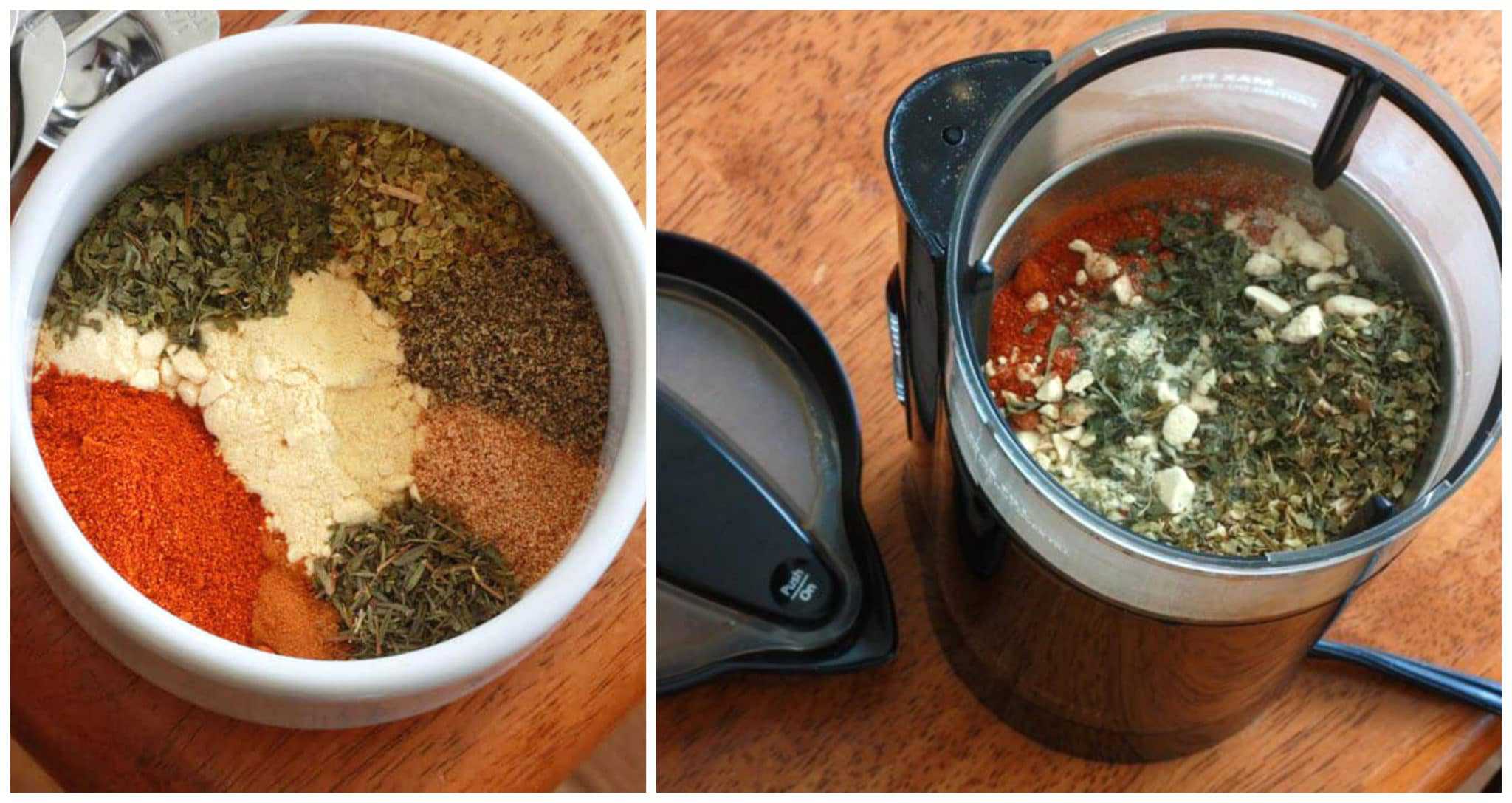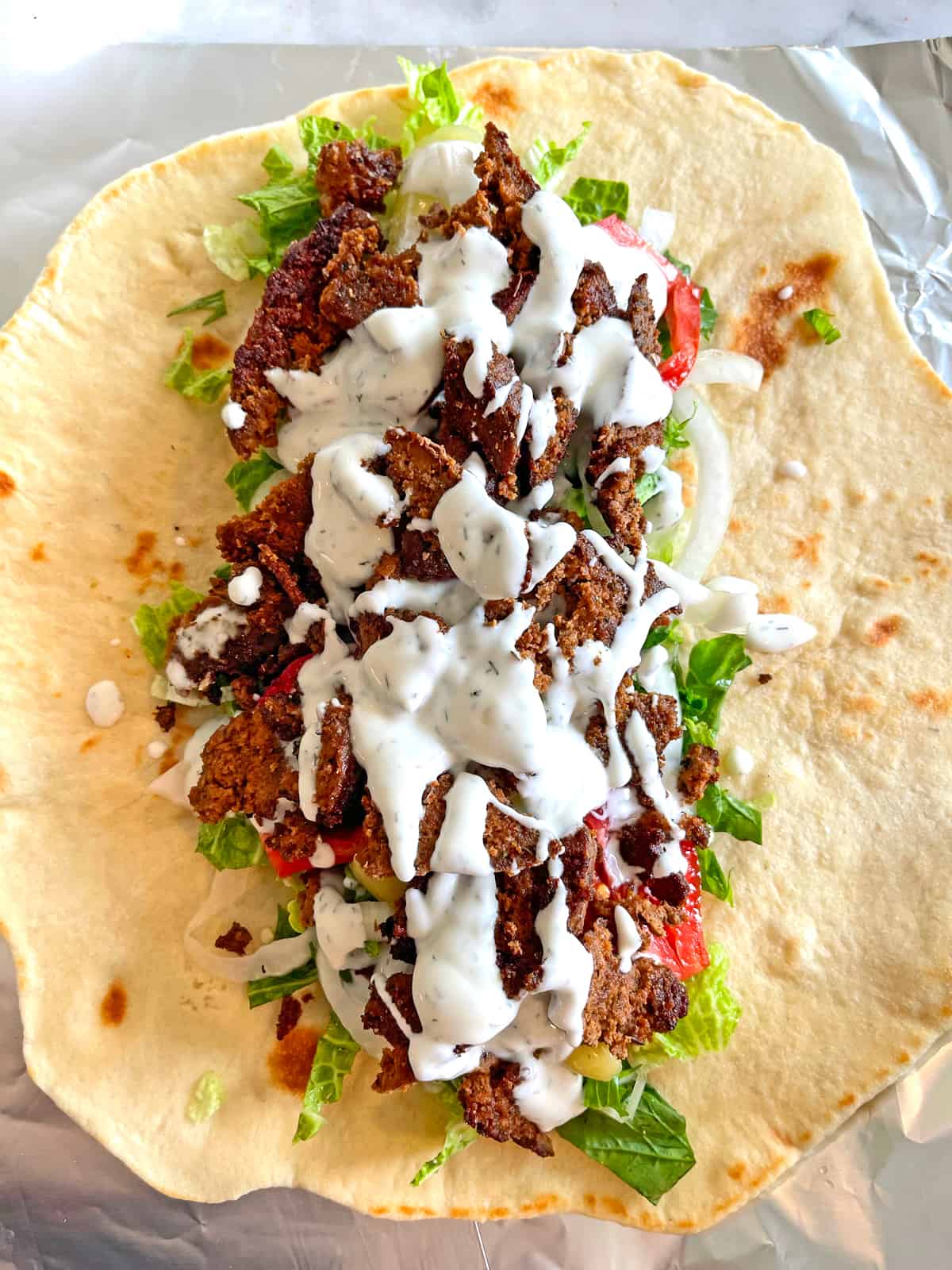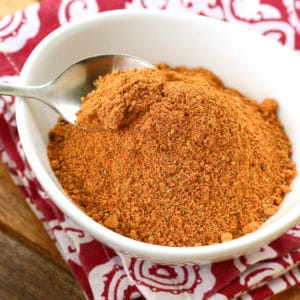Greek Seasoning
This post may contain affiliate links. See my disclosure policy.
Look no further for the BEST Greek Seasoning recipe! Use it on your meats, seafood, pasta, vegetables, salads and dressings and more, this is a fabulous all-purpose seasoning with the perfect blend of flavors!

Why I Love This Greek Seasoning
I developed this Greek Seasoning recipe many years ago after being frustrated with the various blends available on the market. I wanted something bolder, more vibrant, more flavorFUL! And so after experimenting with different ingredients and ratios I finally cracked it….the ultimate homemade Greek Seasoning mix! It’s deliciously versatile and it has remained one of our family’s favorite seasoning blends. It’s the blend I use to make my homemade Greek Gyros and slow cooker Greek Chicken and is so versatile, it makes a great all-purpose seasoning.
It’s super quick and easy to make so you can either make it on demand in small quantities or you can double or triple it and store it to have on hand. Made from scratch, it’s free from additives and preservatives and tastes sooo much better than Cavender’s or the other stuff you find at the store.
Greek Seasoning Recipe
Combine all the spices and grind them to a fine powder in a spice or coffee grinder. I’ve been using my KRUPPS Spice/Coffee Grinder for years and it’s still going strong.
Note: If you prefer the appearance of flaky green herbs in your spice mix you can skip blending it in the grinder. However we recommend grinding it together to ensure an even ratio of ingredients when you shake the seasoning blend onto your food.

Storage
Store your blend in an airtight jar away from light and it will keep for a few months. For the best flavor, make it in small batches and consume within 2 months.

How to Use Greek Seasoning
This Greek Seasoning is a fantastic all-purpose spice blend that will add a Mediterranean flavor twist to a wide variety of foods. Here are just a few ways you can use it:
- Seasoning and Marinating Meats: This blend is excellent for both marinating and seasoning meats. Rub it on chicken, pork, beef, lamb, or seafood before roasting, grilling, baking, or frying. Mix it into ground meat to make Greek-flavored meatballs. I use this to make my Greek Gyros and Greek Chicken.
- Salad Dressing: Mix it with olive oil, lemon juice, and a little vinegar for a zesty salad dressing to drizzle over your Greek salad, feta cheese, fresh veggies, or olives.
- Roasted Vegetables: Toss your favorite vegetables, such as potatoes, carrots, zucchini, bell peppers, and eggplant eggplant, or bell peppers, with this seasoning and olive oil and then roast them in the oven.
- Soups and Stews: Add some to your soups and stews for added depth of flavor. It pairs particularly well with tomato-based soups and bean soups.
- Grains and Legumes: Add some to your grain dishes like rice or quinoa and to lentils and beans while they’re cooking to enhance their flavor.
- Dips and Spreads: Stir some into Greek yogurt or sour cream to create a tasty Greek-inspired dip for fresh vegetables, pita bread, or as a refreshing topping for grilled meats. Remember, the intensity of Greek seasoning can vary depending on the brand or homemade recipe, so adjust the amount you use based on your personal preference. Start with a small amount and gradually add more if desired. Enjoy experimenting with this versatile blend of herbs and spices to add a Greek flair to your meals.
For seasoning meat, aim for about 2 tablespoons of this blend per pound of meat. If using it to season grains like rice, use a tablespoon per cup of uncooked grains. For dip, use 2 teaspoons per cup of sour cream/yogurt.

For more delicious homemade seasoning blends be sure to try my:
- Old Bay Seasoning
- Curry Powder
- Creole Seasoning
- Montreal Steak Seasoning
- Jamaican Jerk Seasoning
- Elote Seasoning
- Sazon Seasoning
- Pizza Seasoning
- Pickling Spice
- Poultry Seasoning
- Seasoned Salt
- Garam Masala
- Chaat Masala
- Dukkah
- Za’atar
- Chili Powder
- Chinese Five Spice
- Shichimi Togarashi
- Mixed Spice
- Taco Seasoning
- Berbere
- Baharat
Save This Recipe

Greek Seasoning Recipe
Equipment
Ingredients
- 1 1/2 tablespoons dried oregano
- 1 1/2 teaspoons salt
- 1 tablespoon onion powder
- 1 1/2 tablespoons garlic powder
- 2 teaspoons freshly ground black pepper (note: freshly ground black pepper is less volume than non-freshly ground, so if using non-freshly ground use about half the amount)
- 2 teaspoons beef bouillon powder
- 2 teaspoons dried parsley flakes
- 1 teaspoon dried thyme
- 1 1/2 tablespoons sweet paprika powder
- 1/4 teaspoon ground cinnamon
- 1/4 teaspoon ground nutmeg
Instructions
- Combine all the spices and grind them to a fine powder in a spice or coffee grinder. Store in an airtight jar away from light until ready to use. Will keep for a few months but for best flavor use within 2 months.Makes about 1/2 cup.
Video
Nutrition
Originally published on The Daring Gourmet on Apr 4, 2013




















Please review your instructions for fresh ground pepper quantities; if we follow your premise that fresh ground occupies less volume (which in itself is wrong, as pre-ground spices compact over time; you don’t even need to grind any pepper to prove that, simply get your container of pepper and transfer some to another vessel, let’s say a shot glass, using a funnel, stop when full and tapping it on its side will magically create some more space to fill), your 2 teaspoons freshly ground would be equivalent to more than, not less, of already ground pepper. Aside from that, as Greek as cinnamon might be, it is not a part of traditional gyro recipes, nor is nutmeg. Your mix might be tasty, but no different than those cooks who surmise that throwing feta and Calamata olives in a recipe makes it “Greek”.
I and most other Americans have not been to Greece. However, I can be fairly certain that the culinary history of Greece as a country follows most, if not all of the many and diversified paths that other countries (and regions) have followed over the centuries. Until the 20th century, people living in most countries rarely traveled more than 50 miles from their home. And the food they prepared was made from recipes based on the ingredients available within 10 or 15 miles of their home. Therefore, there often were huge regional differences on how one prepared a particular dish. And what fun they had arguing about which recipe was the best and/or authentic. There are some ingredients that, while excellent quality, do not “travel” well and therefore are substituted, even today, by local or other ingredients that travel better. Here in the USA, we often craved the “tastes of the world” but again, until relatively recently some of the ingredients were not available in one part of our country or another. Each cook did the best that they could with the ingredients available and we ended up with many regional recipes for the same dish. That is probably the reason that in the USA, the farther you are from, say, Mexico, the less authentic the Mexican food available to you is. That does NOT mean that one region’s version of a dish is better in any way than another region’s. It DOES mean that the people of that region have become accustomed to the version of a particular dish made with ingredients that were historically available to their ancestors. Please keep this in mind when judging someone else’s culinary efforts.
Excellent observation, Pat. Thanks for you insights.
I drooling and want to make this today. For the tomatoes, plain diced or fire roasted; does it matter? Thanks!
Hi Ronni, I’m at a loss – are you referring to a another recipe?
Fantastic recipe:-)
We doubled the spice recipe and mixed that with 3lbs of ground pork and it made perfectly spiced gyros.
Thank you so much for posting this awesomeness!!
Fantastic, Bert, thank you!
Thank you very much for your time and effort in answering my questions
i was wondering, in what other recipes do i need the greek seasoning? thank you
Besides the gyros, it’s a fantastic all-purpose seasoning blend. Use it on pan-fried, baked or grilled chicken or pork, add it to pasta salads, sprinkle it on vegetables, add it to salad dressings…
Hi Kim. Did you, by any chance, try allspice instead of cinnamon in the combination? I am obsessed with trying to find that Greek smell that floats around the greek restaurants. My conclusion is that combined with all other spices, the essential greek taste must be allspice and nutmeg..:-) I will try your combination. I am very excited. And I will try the allspice, too, which is also cinnamony a little, so that the nuance is not lost.
Many thanks for sharing.
That would be a nice addition, Aurora. I’ll have to give that a try next time as well. Happy cooking!
my son ate gyros in hungray and fell in love with it. it seems that hungray greece and turkey all share the same item. i went thru many recipes in the net but i think i will try urs. thank you for the clear step by step photo instructions.
Hi Lamia, there are similarities but the seasonings will vary from country to country. I think you’ll both really enjoy this one – the homemade seasoning is really key. Happy cooking!
Sounds great, I am out of. Bouillon, Any suggestions? I ‘m cooking tonight… thank you so much!
Hi Mary Beth, there’s really no substitute for it so if you can’t get it for tonight just omit it. Happy cooking!
I use cavenders all purpose Greek seasoning. is it similar to your mix?
Hi Lou, this homemade version is significantly different in flavor and it has a very full and vibrant flavor. Using this makes all the difference in the homemade gyros, for example,